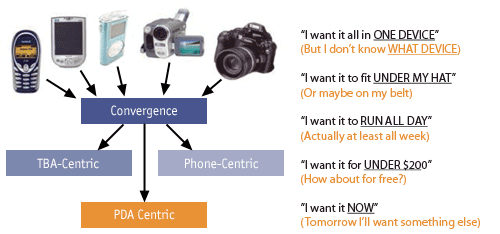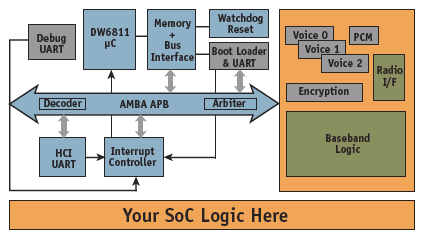Powering the third digital electronics revolution
As the third wave of the digital revolution finally gains momentum, the chip industry is breaking loose from its homogeneous telecom/PC-centric confines – where everyone’s product and box essentially looked and worked the same – into the arms of the fragmented consumer-centric heterogeneous multimedia, with significantly more brand names and lots of different price points.
Solutions not technology are the lingua franca of the third digital wave (Figure 1), with customers no longer forced to assemble the different components of their digital lifestyle, something they are inherently not equipped to do. Products, services and content will become much easier to buy, install and use, from the basic end product to the auxiliary devices and everything in between.

Figure 1. Below 180nm, systematic feature-related yield loss becomes a critical issue.
The characteristics of the third wave are significantly different from the two previous waves, requiring the learning of new rules and new ways of doing business. Accompanying the transition is the move from a highly ordered business model to a hugely diverse, chaotic and churning interconnected world. Long-term supplier relationships – so effective in the second wave – no longer work the same; suppliers earn deals one relationship at a time in the consumer electronics world.
Unlike the previous two waves, the third digital wave touches everyone and everything; technology is on the point of becoming pervasive and ubiquitous, just like electricity and telephony before it. As such, the technology imperative must now be on making it simple to use.
Complexity is currently holding the industry back, plus a lot of what is bought and paid for simply does not get used or implemented. While complaints about complexity and/or technology are hardly new, the economic cost of IT complexity is unacceptably high. The IT effort needed to keep things running smoothly in the business environment is calculated at 25% for the hardware and 75% for the services; the figures were the reverse 15 years ago. In the consumer environment, the cost is incalculable, but includes call centres, help lines, unpatched machines, upgrades and crashes, together with that plethora of unused gadgets and features.

Figure 2. I want more than MTV
The design challenge this poses is how to deliver user-friendly, seamless, cost-effective, leading-edge silicon solutions into the digital (consumer-centric) space and also make a profit in this razor thin margin world. While digital consumers know what products they like – but only after having been given them to try – they are decidedly fickle, demanding hot products today, a different combination tomorrow and something decidedly different thereafter (Figure 2).
Mobile phones are already demonstrating consumer-like features, and before long fashion will be the dominant buying factor over cost, given the pre-requisite that the device actually works. The iPod is a classic example of doing the job right; what is essentially ‘just another MP3 player’ – and one that was very late to market to boot – has turned out to be one of the hottest consumer products ever because of its style, engineering and cool-looking features. If the chip industry could deliver the necessary minor design tweaks to the spec, we could easily see seasonal fashion trends hitting the digital consumer market as well.
Much more important for the digital consumer world is the need to incorporate analog into digital designs, a trend that is driving integrated mixed signal design. This will force through a much-needed change in design methodologies to incorporate true mixed-signal techniques against integrating verified analog blocks into digital designs.
With some of the more visible electronic product successes, like the iPod, appearing to be driven more by marketing innovation than electronic design, design – not technology – will play an increasing role in bringing differentiated products to market. This will force a move away from a bottom-up traditional transistor-level/process IC design approach to a top-down holistic view, in which electronic system-level (ESL) tools play an increasingly important role.
Process nodes change regularly, approximately every two years, but design methods less so, every 10 years roughly. But there is some evidence that we are undergoing such a paradigm shift now, with ESL for the front-end and DFM for the back-end. Quite what impact this will have on the digital consumer electronics market has yet to be seen, but my feeling is that DFM will not be so critical. Digital consumer product success is driven by solutions, not technology, and DFM only really became necessary at the 90nm node and below. One can quite happily envisage a plethora of products that do not require such deep sub-micron technology. Aside from flash memory, most of the IC technology in the iPod is technologically ‘old hat’.
There is also the need to develop not just the fully featured products commanding a relatively high price tag but also the mass-market derivatives offering 80% of the functionality at 20% of the cost. These devices are especially attractive (and necessary) for attracting customers in the less developed world (for example, parts of China, India, the non-EU Eastern Bloc, South America and Africa). It is not yet clear what the impact this will have on system and semiconductor prices and margins, but clearly a seamless common design approach is required.
Given all digital consumer products can be broken down into pre-defined intellectual property (IP) blocks of functionality (an MP3 player, MPEG decoder, MPU core, DSP core, memory, GPS, cell phone block, camera, etc) what is really needed is an more efficient way to stitch this IP together into the SoC device, and the single biggest unknown question today is, “What shape and form should the programmable SoC (pSoC) take for success in the market, both from a device architecture and EDA perspective?”

Figure 3. The IP world and programmable SoC meet
Ideally this interconnect pattern should be flexible, reconfigurable and field programmable, the IP world’s answer to the pSoC problem, just as the FPGA solved the same problem at the logic gate level (Figure 3).
Platform ASICs were once seen as a viable approach to this problem, but have taken a knock recently following LSI Logic’s withdrawal from the market. These and other similar devices simply do not quite hit the sweet spot of digital consumer user IP reuse and reprogrammability.
Technology marches on, opening new markets, expanding old ones, and enhancing our lives, with the fallout at the macro level affecting the entire world economy. The market for electronic products, traditionally a Japanese, North American and Western European domain, now encompasses the whole of the Asian rim, China, Eastern Europe and India – a middle class market growth from 500 million to three billion people.
From the chipmakers’ perspective large markets will get larger, niche markets will become commodities, and new niche markets will arise, and if the lessons of history hold true to past form, the third-wave market leaders will be significantly different for today’s second-wave world. Far from the semiconductor market maturing, the industry is still in a volatile growth phase, with at least a further 20 years to develop. Finally after two decades of boredom, the chip industry is starting to get interesting and fun again, this time driven by the digital consumer revolution.


